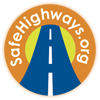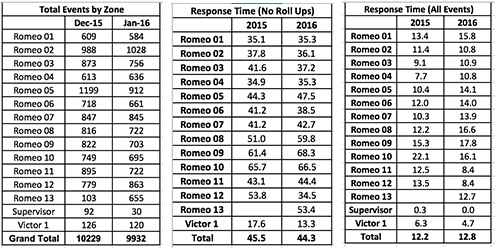Accountability Ensures Safety Service Patrols’ Success
by Tara Baukus Mello
Safety Service Patrol (SSP) drivers are often the public “face” of the transportation agencies they represent. When attending to stranded motorists on the side of the highway, they not only need to meet certain safety standards, but also customer service standards, to ensure the program’s overall success. As such, SSP managers are continually seeking ways to measure the performance of SSP drivers on the job and hold them to the highest standards possible.
Industry expert Steve J. Cyra, associate vice president of traffic operations/ITS for HNTB Corporation, explains: “Since SSP programs are largely a public safety service that involves direct interaction with motorists, it is imperative that DOTs and other operating agencies be accountable for the quality of services rendered, much in the same way a DOT field inspector monitors the workmanship of a roadway or bridge construction contractor.”
INCIDENT REPORTS
Many transportation agencies use computer software, such as SunGuide, to assess the accountability of their SSPs, in both formal and informal ways. They log specifics of each call to which an SSP responds, including date and time, location, weather, the type of call, response time, and the length of time on the actual call, among other data.
Michael Washburn, incident program manager for Florida’s Turnpike Enterprise, explains how the Turnpike utilizes its incident report data: “The information is used to help see where the overall program can be enhanced and improved. The number of assists and response times helps in determining patrol zone limits and coverage times as well as Road Ranger vehicle type needs.” Washburn continues, “Florida’s Turnpike has both urban coverage areas and very rural coverage zones. The tracked information helps us determine where we need to add or reduce coverage, and what Road Ranger vehicle type may be best for that zone. For example, in a zone where we have a majority of crashes due to construction, we’ll add a wrecker to help clear the roads quicker.”
In West Virginia, the Courtesy Patrol drivers and dispatchers complete incident reports, which are then entered into a database. The data is compiled twice monthly into a report, which is then sent to the Governor, the West Virginia Department of Transportation, as well as other stakeholders.
INTERAGENCY AND MOTORIST FEEDBACK
In some cases, feedback from first responders, including police, fire, and EMS personnel, as well as the motorist(s) assisted during the call, is also incorporated into the logs to track accountability. Feedback is often discussed directly with the SSP driver in an informal way, or formally, such as during an annual review, or by the driver receiving formal recognition for outstanding service.
Feedback from other first responders tends to carry a lot of weight with transportation agencies, which in turn use the information to assess their SSP program overall, as well as to praise or retrain staff based on the feedback. Most transportation agencies collect feedback of their SSP’s performance from first responders and the public through comment cards, phone calls, e-mails, and social media. “Unfortunately,” Cyra notes, “many agencies still rely on hardcopy version of surveys or comment cards, which is much more labor intensive to compile and often takes longer to react to [each comment].”
The Florida Department of Transportation conducts an annual survey of other first responders on its Florida Road Rangers’ performance. Available online during the first quarter of each year, first responders and other traffic incident management responders throughout Florida receive links to the survey, which is completed anonymously. In addition to multiple-choice questions that provide a scale to measure the patrol’s performance, the survey asks open-ended questions to help identify additional areas of improvement. The resulting data is compiled into a spreadsheet for analysis. The most recent survey, for example, noted a need for direct communication via radio between Road Rangers and on-scene responders.
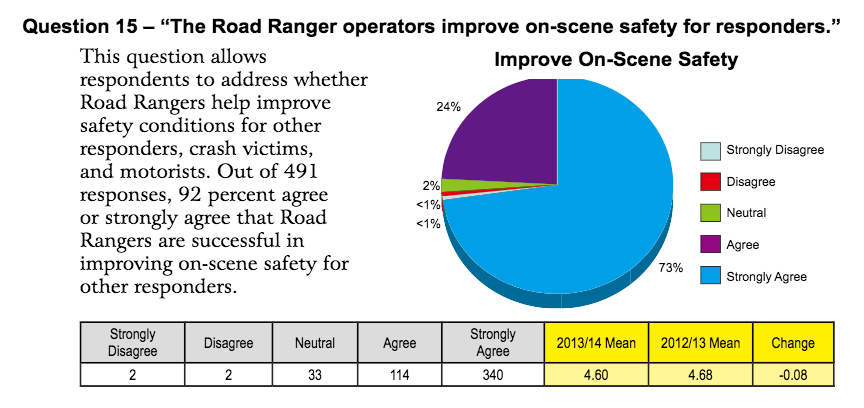
FDOT releases an annual survey for incident responders to provide feedback on their experience working with Road Rangers (above excerpt is from the 2013-2014 report).
Cyra notes the importance of this data: “Law enforcement, fire, EMS, transportation, SSPs and towing/recovery providers all have to work as a team and have to watch each other’s back. Information received is taken very seriously, especially when safety is impacted.” Cyra adds, “When any one of these teammates demonstrates poor or unsafe performance it is the responsibility of the others to bring it to the attention of the incident commander or operating agency(ies) where it is addressed with corrective action.”
On the other hand, it is a matter of some debate as to how helpful comment cards distributed to assisted motorists are in assessing performance. John McClellan, freeway operations supervisor for the Minnesota Department of Transportation (MnDOT), explains that its Freeway Incident Response Safety Team (FIRST) used comment cards in the past, “but their usefulness was found to be positively skewed by operators who only gave out the cards to those from whom they expected a positive review.” Currently, unsolicited feedback from the public via phone calls, emails, or social media, carries more weight in assessing performance and is shared with the driver, the direct supervisor, and the management staff.
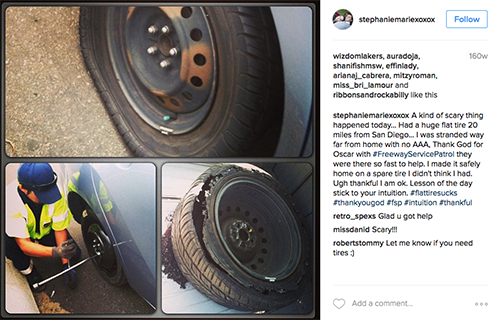
Unsolicited feedback can carry more weight in some states than feedback solicited via comment cards. Assisted motorists often take to social media to share their thanks for the services rendered, like this post from a motorist outside of San Diego.
To encourage customer feedback in Florida, each Turnpike Road Ranger hands out a business card, which directs customers to an online comment card and explains how to provide feedback via social media using a program hashtag. In addition, comments received via e-mail and phone are also tracked. “Comments, both good and bad, are then provided to managers monthly,” says Washburn.
David Castillo, assistant manager of the Courtesy Patrol Division for the Dallas County Sheriff’s Department, notes that negative responses to the comment cards that drivers hand out in Dallas County are rare and patrollers are supposed to give the comment card at the end of every call. “We do a breakdown of them monthly and every six months, I review,” Castillo says. “Patrollers who get a lot of positive responses will get a Letter of Commendation. Responses are part of each patroller’s annual review and it carries weight in terms of getting a positive review, but it doesn’t change their level of compensation, simply because we don’t have the budget.” The MnDOT also uses the feedback it receives on its FIRST drivers to issue recognition awards and letters to praise its drivers who have consistently exceeded expectations.
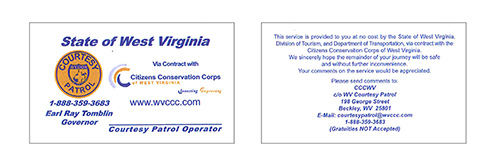
West Virginia Courtesy Patrol drivers distribute these comment cards to assisted motorists to solicit their feedback on the service.
Similarly to the Dallas Courtesy Patrol and MnDOT’s FIRST, comment cards are used as one metric of employee evaluations for drivers of the West Virginia Courtesy Patrol. Jennifer Douglas, executive director of the West Virginia Courtesy Patrol, explains: “We value the customer’s opinion and use it in the review of the overall program performance, while feedback with the applicable patrol drivers occurs on a case-by-case basis.”
MONITORING
There are multiple ways that transportation agencies hold SSP drivers accountable. To ensure that drivers are well prepared to handle medical issues they may encounter, agencies conduct regular training sessions for First Aid, CPR, and disaster response preparedness. All of the agencies interviewed conduct routine safety checks and SSP driver’s license checks. Many also use various forms of monitoring to oversee drivers while they are on the road.
For example, Florida’s Turnpike State Farm Safety Patrol drivers are observed on camera by Traffic Management Center Operators frequently, in part to monitor their actions. “Operators provide immediate feedback to the Road Ranger and the manager whenever they see any actions that are out of protocol or unsafe. Individual Road Rangers have been coached, re-trained and disciplined based on this coordination,” says Washburn.

A common practice among Safety Service Patrols is to pull video from the Traffic Management Center (TMC) or dashboard cameras to be used for future training purposes.
However, not all agencies have the ability to monitor their SSPs that closely. In Minnesota, the department of transportation has been looking into using a camera on the patroller’s body, similar to law enforcement officers, or using a dashboard camera in the vehicle, but funding is not available to add such features at this time. Currently, MnDOT uses its extensive network of traffic camera video, both in real time and in video replays, to monitor the safety and well-being of drivers during their stops. These videos are also used later as training tools.
Cyra notes, “SSPs are one of the most, if not the most, cost-effective Transportation Systems Management and Operations strategies available. Given their importance and the dangerous environment they work in, it is critical that these professionals receive proper training to keep them safe while they enhance the safety and mobility of the traveling public.”
During training, SSP drivers learn the expected standards of performance. Regular measurement of said standards, is critically important to the success of Safety Service Patrol program. Program metrics offer a means to: 1) address areas for improvement, such as equipment and vehicle updates for efficiency and safety reasons; 2) determine training needs to meet performance standards; and 3) acknowledge success, both individually and as a team. And that performance is measured continually to identify needs for retraining.
